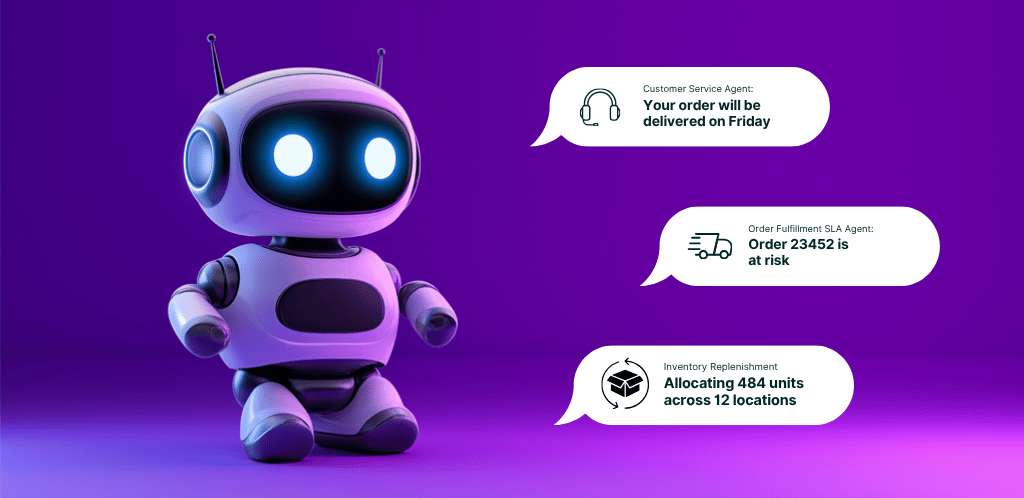AI agents are transforming how retailers operate. Unlike traditional automation that follows rigid rules, AI agents can reason, make decisions, and take action autonomously. They monitor your business continuously, spot problems before they escalate, and fix issues without human intervention.
Here are six AI agent use cases that leading retailers are implementing today.
1. Customer Service: Where Is My Order? (WISMO)
The Challenge
Order status inquiries often make up 40-60% of customer service calls, and each call can easily cost $5 – $6 to handle. As your business grows, hiring more people to handle routine questions becomes expensive.
How the AI Agent Works
When a customer asks about their order in natural language, the AI agent understands their intent. It then retrieves the current order status from your order management system, and responds with a clear, conversational answer. The entire interaction happens instantly, without human involvement.
Business Benefits
- Dramatically reduces cost per inquiry
- Enables 24/7 customer service
- Supports growth without additional headcount
- Frees your service team to handle complex issues that truly need human attention
- Scales effortlessly during peak seasons
Key KPIs Impacted
- Customer service cost per inquiry
- First contact resolution rate
- Average handle time
- Customer satisfaction scores
2. Order SLA Management: Before an Order Ships
The Challenge
Ship-from-store operations must balance online order processing with serving in-store customers. When foot traffic surges, order processing slows down, putting delivery promises at risk.
How the AI Agent Works
The agent continuously monitors order age and processing time at each store location. When it detects that processing times are increasing and orders risk missing their service level agreements, it automatically reroutes orders to other locations. It could also take actions based on your business needs. For example, it could ‘turn off’ ship-from-store for a period of time at the affected location.
Business Benefits
- Protects delivery promises even during unexpected spikes
- Optimizes the use of your entire fulfillment network
- Prevents customer disappointment and potential cancellations
- Maintains healthy in-store customer experience
Key KPIs Impacted
- On-time shipment rate
- Order promise compliance
- Ship-from-store efficiency
- Customer retention rate
3. Order SLA Management: After an Order Ships
The Challenge
Carriers performance. Often 5-10% of orders experience delays, and a small percentage get completely lost in transit. Customers often discover these issues before you do. This leads to frustration and increased service calls.
How the AI Agent Works
The agent monitors real-time delivery updates from all your carriers. When it identifies that an expected delivery date has shifted beyond your promise date, or a package is stuck in transit, it takes action. For example, it could proactively offer the customer an appeasement to offset the delay. Or, create a replacement shipment and proactively notify the customer.
Business Benefits
- Turns service failures into moments of delight
- Reduces inbound complaint calls
- Improves customer lifetime value
- Minimizes revenue loss from refunds
Key KPIs Impacted
- Delivery promise compliance
- Customer complaint volume
- Net Promoter Score
- Cost of service failures
4. Safety Stock Optimizer
The Challenge
Setting the right inventory levels is a constant balancing act. Stock out, and you lose sales. Overstock, and you tie up capital in stale inventory that may need to be marked down. Manual adjustments can’t keep pace with changing demand patterns.
How the AI Agent Works
The agent analyzes sales patterns, seasonality, lead times, and demand variability for each item at each location. It automatically fine-tunes minimum and maximum stock levels and safety stock quantities. The agent balances the cost of stockouts against the cost of carrying excess inventory, and optimizes for your specific service level targets.
Business Benefits
- Reduces both stockouts and excess inventory simultaneously
- Adapts quickly to changing demand patterns
- Improves working capital efficiency
- Minimizes markdown losses on stale inventory
Key KPIs Impacted
- In-stock rate
- Inventory turnover
- Gross margin return on investment (GMROI)
- Working capital requirements
- Markdown percentage
5. Inventory Replenishment Optimizer
The Challenge
Having inventory is not enough. It needs to be in the right place at the right time. Poor placement leads to split shipments and expedited delivery costs. Not to mention lost sales when popular items are out of stock in high-demand locations.
How the AI Agent Works
The agent analyzes demand patterns across your entire fulfillment network. Optimizes replenishment, ensuring it’s based on demand, not just the source of fulfillment. It automatically triggers inventory transfers between distribution centers and stores if needed to prevent forecast stockouts and avoid split shipments. This ensures products are positioned where they’re most likely to be needed.
Business Benefits
- Reduces split shipments and associated shipping costs
- Increases ship-from-store success rates
- Improves inventory availability where customers want it
- Lowers expedited freight expenses
Key KPIs Impacted
- Perfect order rate
- Units per transaction
- Outbound freight cost per unit
- Regional stock availability
- Store fulfillment capacity utilization
6. AI-Driven Software Development
The Challenge
Development backlogs grow faster than engineering teams can deliver. A typical feature requires research, development, testing, and documentation. This can take weeks to complete, limiting how quickly you can adapt to business needs.
How AI Agents Work
With AI agents, using a human-in-loop-approach, development cycles can be cut significantly. Product owners input requirements, and AI agents ask clarifying questions to refine them. An agent turns the requirements into tickets which are reviewed by a senior developer. Then multiple specialized AI agents work together to write code, test the code, document it, and commit it to your code repository. Then a senior developer can review and merge it. The entire process takes a few hours instead of a couple of sprints.
Business Benefits
- Accelerates time to market for new features
- Enables daily releases instead of monthly or quarterly updates
- Amplifies the productivity of senior developers
- Allows faster response to competitive pressures
Key KPIs Impacted
- Development cycle time
- Feature deployment frequency
- Engineering cost per feature
- Time to market for strategic initiatives
Getting Started with AI Agents
The retailers seeing the most success with AI agents start with a clear business problem and measurable outcomes. They choose use cases where the agent can access reliable data, the decision criteria are well-understood, and the business impact is significant.
The good news? If you’re using a modern order management system like Fluent Order Management, much of the data these agents need is already available. The infrastructure is ready. The question is simply: which problem will you solve first?
AI agents aren’t replacing your teams, they’re multiplying their effectiveness. They handle the repetitive monitoring and routine decisions, freeing your people to focus on strategy, exceptions, and the complex situations that truly benefit from human judgment.
The competitive advantage goes to retailers who move quickly. Those who implement AI agents now will operate more efficiently, serve customers better, and adapt faster than those who wait. If you want to find out how Fluent Order Management can ensure your AI agents are effective, contact us today.



